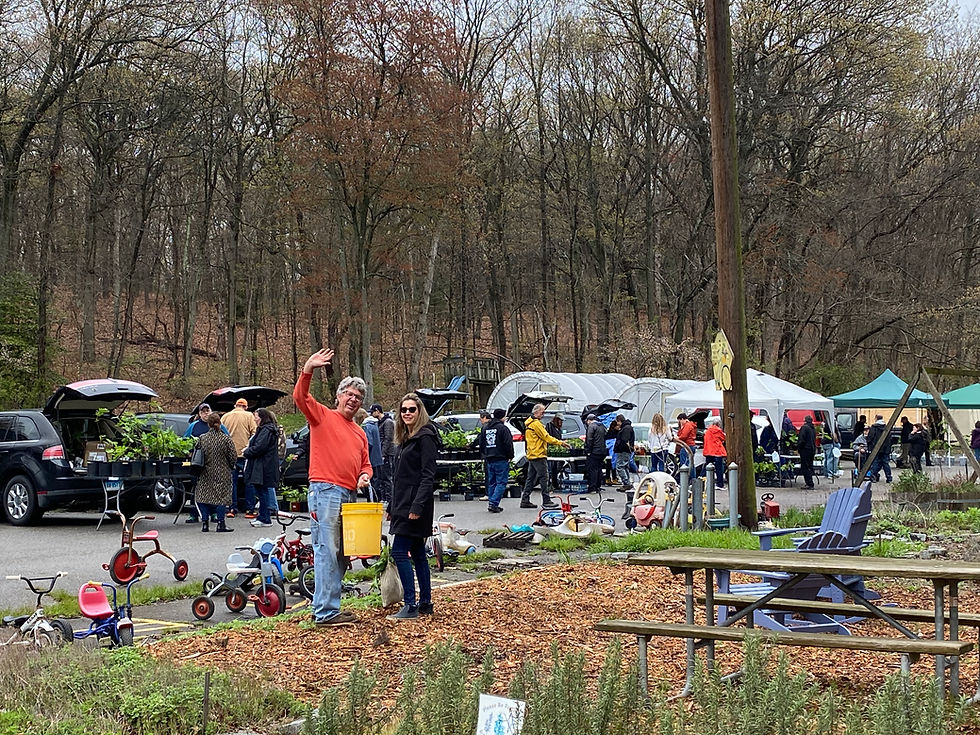April Action
- caroline147
- Apr 21, 2024
- 5 min read
Updated: Apr 22, 2024
I always forget how beautiful the farm is this time of year. With all the trees in various stages of bloom, you can squint your eyes and imagine yourself in a Hudson River School painting. It’s a fleeting piece of heaven here on earth.

The new blackberry trellis is finally complete! But before we arrived at this happy moment, I spent weeks scratching my head, agonizing over how to affix 330’ of wire to the locust posts. A commercial roll of 12 gauge wire is rigid, susceptible to kinking, and very heavy; locust posts, meanwhile, are resistant to staples, nails, and even screws. With no clear memory of how we did it in 2008, I paid a visit to Mick Makinajian, my berry mentor since that same year. I arrived expecting a wealth of trellis installation tips, but quickly realized if you get your trellis right the first time, you won’t need to revisit it for 30+ years. So my visit didn’t deliver much in terms of installation tips. Mick did, however, provide a wealth of berry growing tips, which are always appreciated. Back to the trellis, Dan found a DIY video showing how to turn a small piece of conduit into a wire fastening tool, and bingo! The wire went up in no time. The finished product looks great, and hopefully we won’t have to do it again for 30+ years.

Peas are the season’s first transplants, and they went into the ground three weeks ago. For this, we use a paperpot transplanter, a big, clunky contraption that unfurls a paper ribbon of seedlings. Under optimal conditions, the transplanter can set 264 plants in the ground in 30 seconds. The transplanter works best in a finely prepared seedbed—the kind you’d get from a rototiller—but in our low-till system of recycled zones and intercropped pathways, chunky soil and crop residue interfere with optimal performance. Nevertheless, the paperpot system is still a big improvement over direct seeding. Before we switched, pea seed germination could be as low as 50%; with the paperpot system, 85% of the transplants make it to maturity. Go peas!

Last week was a transplanting frenzy. Beets, lettuce, bok choy, kale, and chard. This week it will be onions and potatoes. Next week it will be spinach and strawberries. As the fields fill up, and we switch from referencing field maps to referencing fields, the season transitions from abstract to anchored. It’s a satisfying feeling.

Did you catch the solar eclipse? We sure did! On April 8, a group of 20 gathered in New Pond Field to don our glasses and wait for the subtle dimming of the sky and cooling of the air. Though not nearly as spectacular as a total eclipse, it was nonetheless a special event to experience among friends.

The weekly Saturday farm stand is back. It was chilly and rainy for our soft re-opening, but we were open anyway with the last of the storage crops, the first of the plants, and John DellAquila, founder and baker of Johnny Breads. John stole the show with an abundant assortment of sourdough loaves, rolls, and croissants, and he will be back every Saturday this season. Outside the Tin House, Figstock was in full swing. Launched in 2020 by CSA member Esther Klein, and organized by the Long Island Fig Network, Figstock is a biannual event where people trade, sell, and talk figs until they’re blue in the face. The rain was no match for these die-hards—they came with umbrellas, pop-up tents, and thousands of potted figs and cuttings. Lucky for us, the sun broke through at the end of the morning and warmed everyone up.






















Comments